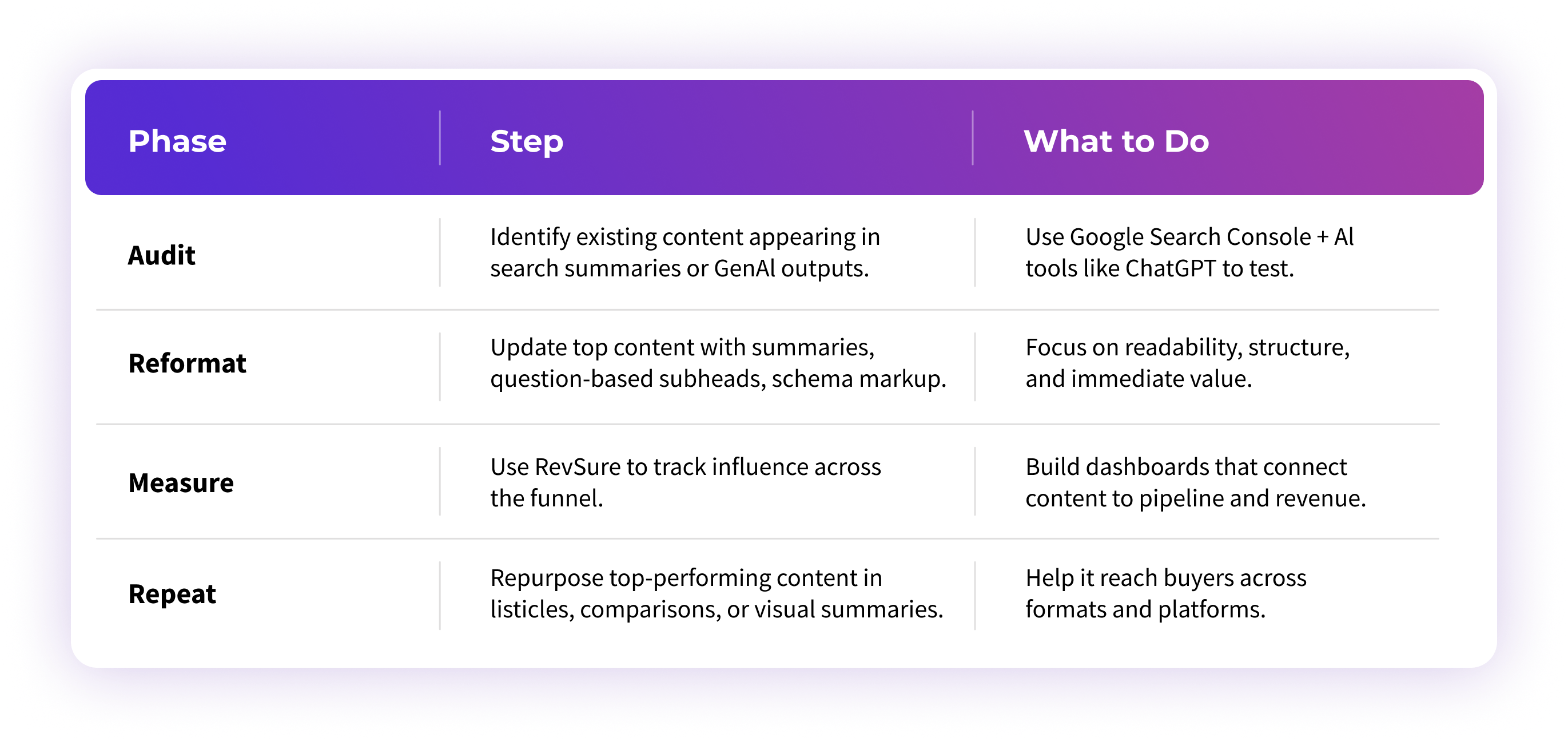

Book a Demo
Thank you! Your submission has been received!
Oops! Something went wrong while submitting the form.
B2B buyers are evolving, and so should your content strategy. In an era dominated by instant answers, AI-generated summaries, and hyper-efficient research habits, more buyers are making decisions before they even visit your website. Welcome to the era of zero-click content, where trust and visibility matter more than traffic.
This blog dives deep into what zero-click content means for B2B marketers, how to optimize for it, and, most importantly, how to measure its impact beyond vanity metrics like clicks.
Zero-click content refers to any digital content that fulfills the user's intent without requiring a click-through to a website. Examples include:
While this phenomenon was first observed in B2C and local SEO, it's now becoming mainstream in B2B search behavior—especially as buyers use GenAI tools for research.
In B2B, buyers conduct 70-80% of their research anonymously. What’s changed now is how they conduct it. According to Forrester, nearly 9 in 10 B2B buyers now use generative AI during their decision-making process. These tools don’t just refer buyers to websites; they summarize content, distill comparisons, and suggest best-fit vendors on the spot.
The result? Fewer clicks but higher expectations. If your content doesn’t appear in search summaries or AI responses, you’re invisible, even if your product is superior. That’s why zero-click content is a competitive edge. It’s how you show up in moments that matter, even if the user never lands on your homepage.
Let’s say a buyer is researching the value of full-funnel attribution tools. Here’s what zero-click content looks like:
Query: “What is full-funnel attribution?”
Answer: A concise definition pulled from a vendor’s blog—without needing a click.
Query: “Top KPIs for revenue marketers”
Answer: A featured list of metrics like pipeline velocity, win rate, influenced revenue.
Query: “RevOps tools comparison”
Answer: A Google AI Overview summary pulling in vendor names and features from various content sources.
In each of these cases, the first impression happens off-site. If your content structure and SEO aren’t designed for this behavior, you lose the chance to influence the buying journey.
To earn visibility without a click, you need to reverse-engineer how search engines and AI tools surface answers.
1. Start With the Answer
Open every blog or landing page with a concise summary that directly addresses the target query. Think: one or two clear, scannable sentences.
Example:
Full-funnel attribution is the process of mapping every touchpoint in a buyer’s journey, from anonymous engagement to closed-won revenue across marketing and sales.
2. Use Question-Based Subheadings
Match your H2s and H3s with the way your buyers search:
This signals to search engines that your content is structured for answers.
3. Leverage Lists and Tables
Search engines prioritize content that’s easy to parse. Use bullet points, numbered lists, and comparison tables wherever possible. These formats are more likely to appear in featured snippets and AI responses.
4. Add Schema Markup
Implement structured data (like FAQ, HowTo, Article, Product) using schema.org markup. This makes your content eligible for rich results on Google.
5. Write for Summarization
Short paragraphs. Clear logic. No fluff. AI summarization tools favor clean, well-structured content over marketing-speak or jargon.
To ensure your content gets picked up in search summaries and GenAI tools:
Here’s the hard truth: traditional KPIs like pageviews and CTR are no longer sufficient. To understand the real impact of your content, especially in B2B, you need to measure influence, not just traffic.
1. Impressions & Search Position
Use Google Search Console to track how often your content shows up in search, especially in featured snippets.
2. Engagement Quality
When users do click:
Use tools like Hotjar, GA4, or HubSpot for this analysis.
3. Attribution & Content Influence
Track how each content asset contributes to lead conversion, pipeline progression, and closed-won revenue. Even if it’s not the first or last touch, is it part of the journey?
In a world of AI summaries and anonymous research, RevSure helps marketing teams connect the dots, even when there’s no direct click path.
With RevSure, you can:

In the age of AI-powered search and zero-click behaviors, content that gets seen matters more than content that gets clicked. As B2B marketers, it’s no longer enough to track traffic or form fills. You need to:
Zero-click isn’t the end of content performance; it’s the beginning of a smarter, more visible, and more buyer-aligned marketing strategy. With the right content structure and a measurement engine like RevSure, you’ll not only stay visible; you’ll drive the kind of influence that actually moves the business forward.

